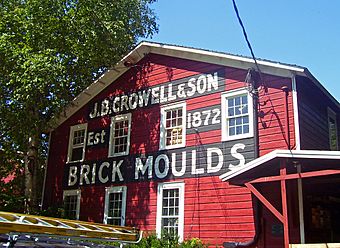J. B. Crowell and Son Brick Mould Mill Complex facts for kids
Quick facts for kids |
|
|
J. B. Crowell and Son
Brick Mould Mill Complex |
|

Main building of the complex, in 2007
|
|
| Location | Wallkill, NY |
|---|---|
| Nearest city | Newburgh |
| Built | 1872 |
| NRHP reference No. | 83001814 |
| Added to NRHP | 1983 |
The J. B. Crowell and Son Brick Mould Mill Complex was an important factory located in Wallkill, New York. It was known for making special wooden moulds used to shape bricks. This historic site is part of the Town of Shawangunk in Ulster County.
The mill was started in 1870 by James Burns Crowell. He decided to open this business after changing his mind about being a teacher. The complex was added to the National Register of Historic Places in 1983. This means it is recognized as a special place in American history. The mill stopped its operations in 2020.
Contents
What the Mill Made
The J. B. Crowell and Son Mill made many useful items. Its main product was wooden moulds for bricks. These moulds helped workers create bricks in the right shape and size.
More Than Just Bricks
Besides brick moulds, the factory also produced other wooden tools. These included wheelbarrows, which are used to carry heavy things. They also made oxbows, which are parts of a harness for oxen. A fun fact is that the mill also made children's sleds for winter fun!
History of the Complex
The mill began its work in 1870. James Burns Crowell was the founder of this interesting business. He wanted to create a place that made important tools for building and farming.
Building the Mill
Just two years after starting, in 1872, many of the buildings you can still see today were built. These structures helped the mill become a busy and successful place. They allowed for more production of brick moulds and other wooden items.
Becoming a Historic Site
In 1983, the J. B. Crowell and Son Brick Mould Mill Complex was added to the National Register of Historic Places. This honor means the site is important to the history of the United States. It helps protect the buildings and teaches us about how things were made long ago.

